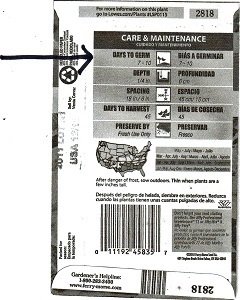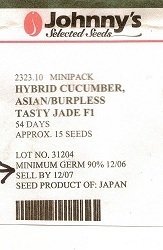





The old adage "you get what you pay for" certainly applies when ordering seeds whether it be vegetable or flower. When you go to a dollar store and buy ten packs of seeds for a dollar, don't expect quality plants or high germination rates. Many of these "cheaper" seeds contain large amounts of weed seeds and or fillers.
The first issue that I want to discuss is where to find and how to identify quality seeds companies. The first place I suggest to look is the Garden Watchdog. There you will find thousands of companies with reviews from gardeners just like you and me.
Fellow gardeners are another great source for recommendations; ask neighbors and garden club members where they purchase their seeds and how they feel about the quality of the seeds that they purchase.
I've been gardening for over 45 years and have narrowed my preferred seed providers down to a short list. Johnny's Selected Seeds, Baker Creek Heirloom Seed, Tomato Growers Supply, Burpee, Ferry-Morse, Seed Savers Exchange and Territorial Seed Company are just a few of the companies that I've purchased from and have had success. This is not to say that there aren't other quality companies out there. Most gardeners are more than willing to try new seeds and or companies at the drop of a hat.
You also have the option to purchase the seeds locally at garden centers and big box stores. However, as a rule these outlets usually carry only the most popular varieties and you have much less choice, especially for rarer varieties. I've also noticed that usually these packets have a lesser amount of seeds than those purchased through catalogs.
Date packed: Little explanation is needed here, obviously the year in which the seeds where packaged. But that is not to say seeds that are a year old aren't any good. If stored properly seeds will be viable for a number of years. I will discuss proper storage a little bit later.
Days to Germination: The average number of days between sowing and seed germination. Usually expressed in a 3 to 4 day range. This estimate is based on starting the seeds at the optimum germination temperature range.

Optimum Germination Temperature Range: The temperature range which is the ideal for optimum germination. Usually between 70 and 80 degrees F.
Days to Maturity (Days to harvest): The number of days between either setting transplants into the garden, or if direct seeding when you can expect to begin harvesting. Note that this period is affected by factors such as temperature, amount of rainfall or irrigation fertilization etc.
USDA Zone Map: Many companies include a USDA zone map on their packages to demonstrate the correct planting dates in your particular zone.
 USDA Zone Map gives the proper planting time for your area
USDA Zone Map gives the proper planting time for your area
Minimum Germination Rate: The percentage of seeds that you can expect to germinate. For example of you have seeds with a lower germination rate and you are looking for a certain number of plants from which to transplant you will want to plant a higher number of seeds in order to achieve the expected number of plants.

Depth: The depth in which to plant the seeds into the soil.
Spacing: The distance between plants as well as the distance between rows.
Seed Storage: If stored properly seeds will remain viable for many years.
Vegetable and flower seeds may be kept for one year without appreciable decrease in germination.
Storage may be extended to 10 or more years under proper conditions.
Seed moisture and storage temperature are the most important factors in determining how long seed can be stored.
The drier the seeds are, the longer they will store.
I prefer to store my seeds in paper envelopes within a sealed Mason jar.
Place a tablespoon of dry milk into a paper napkin and tie with a string. Add to the jar of seeds. The dry milk will absorb any moisture that might be present.
Here are some examples of the length of time that some seeds will remain viable if stored properly.
Plant Years Plant Years Asparagus 3-4 Ageratum 4 Beans 3-6 Alyssum 4 Beets 3-4 Anemone 2 Broccoli 4-5 Aster 1-2 Cabbage 4-5 Calendula 5-6 Cauliflower 4-5 Carnation 4-5 Corn 4-6 Lobelia 3-4 Eggplant 3-5 Lupine 1-2 Leeks 2-4 Coreoopsis 2 Lettuce 3-4 Delphinium 1 Onions 2-4 Gaillarda 2-3 Peppers 3-5 Gomphrena 2-3 Radish 3-5 Heliotrope 1-2 Spinach 3-4 Shasta daisy 1-2 Tomato 4-7 Sweet Pea 2-3 Turnip 5-8 Verbenia 1Copyright © www.100flowers.win Botanic Garden All Rights Reserved